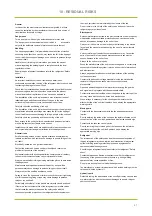
56
9 - MAINTENANCE
SAFETY WARNINGS FOR OPERATIONS ON UNITS CONTAINING R32
•
The recovery equipment and tanks comply with
suitable standards.
•
If possible, pump the cooling system.
•
If it is not possible to obtain a vacuum, make
sure that a collector removes the refrigerant
from various parts of the system.
•
Before proceeding with the recovery, check that
the tank is located on the scales.
•
Start up the recovery machine and use it
following the instructions by the manufacturer.
•
Do not fill the tanks excessively. (Do not exceed
80% of the liquid volume).
•
Do not exceed the tank's maximum operating
pressure, not even momentarily.
•
Once the tanks are filled correctly and the
process is over, make sure that the tanks and
equipment are immediately removed from the
site and that all insulation valves on the
equipment are closed.
•
The refrigerant recovered must not be loaded
into another cooling system unless it has been
cleaned and checked.
Labelling
Equipment must be labelled reporting the
dismantling and emptying of the refrigerant.
Labels must be dated and signed.
Make sure all the equipment is labelled and
reporting the presence of flammable refrigerant.
Recovery
When removing the refrigerant from the system,
please adopt good practices to remove all
refrigerants safely in case of both assistance or
decommissioning operations.
When transferring the refrigerant into the tanks,
make sure only suitable tanks are used to recover
the refrigerant.
Make sure enough tanks are used.
All the tanks to be used are designated for the
recovered refrigerant and are labelled for that
specific refrigerant (e.g. special tanks for refrigerant
collection.
Tanks must be equipped with a perfectly-functioning
safety valve and relative interception valves.
Empty recovery tanks are evacuated and, if
possible, cooled before recovery.
Recovery equipment must be perfectly functioning
with the respective instruction booklets at hand and
they must be suitable to recover flammable
refrigerants. A series of perfectly-functioning
calibrates scales must also be available.
Flexible tubes must be equipped with leak-proof
disconnection fittings in good condition. Before
repeated until there is no trace of refrigerant in the
system.
When using the final OFN charge, the system must
be vented to the atmospheric pressure
to allow the intervention. This step is essential to
perform
brazing operations on the pipes.
Make sure that the vacuum pump intake is not near
ignition sources and that there is
suitable ventilation.
Charging operations
In addition to conventional charging operations, the
following requirements must be complied with:
•
When using charging equipment, make sure that
the various refrigerants are not contaminated.
Flexible tubes or conduits must be as short as
possible to reduce to the minimum the quantity
of refrigerant contained.
•
Tanks must be kept in a vertical position.
•
•
Before loading the system with refrigerant, check
that the cooling system is earthed.
Label the system when fully charged (unless
already labelled).
•
Make sure not to fill the cooling system
excessively.
•
Before recharging the system, the pressure must
be tested with OFN. A leak test must be
performed after the charging operations but
before commissioning. Before leaving the site,
perform an additional leak test.
Dismantling
Before performing this procedure, it is essential that
the technician has become familiar with the
equipment and the relative details.
We recommend employing good practices for a safe
recovery of the refrigerants.
Before performing the operation, take a sample of
oil and refrigerant should an analysis be necessary
before reusing the regenerated refrigerant. Before
performing the operation, check the availability of
electricity.
•
Become familiar with the equipment and how it
functions.
•
Electrically isolate the system.
Before attempting the procedure, check that:
•
The mechanical manipulation equipment is
available, if necessary, to handle refrigerant
tanks;
•
All the personal protection equipment is available
and employed correctly;
•
The recovery procedure is monitored at all times
by skilled personnel;
Содержание AIRFLOW2020
Страница 2: ......
Страница 11: ...9 NOTES...
Страница 35: ...33 NOTES...
Страница 69: ...67 NOTES...
Страница 70: ...68 NOTES...
Страница 79: ...9 NOTES...
Страница 103: ...33 NOTE...
Страница 138: ...68 NOTE...
Страница 139: ...74 NOTE...







































